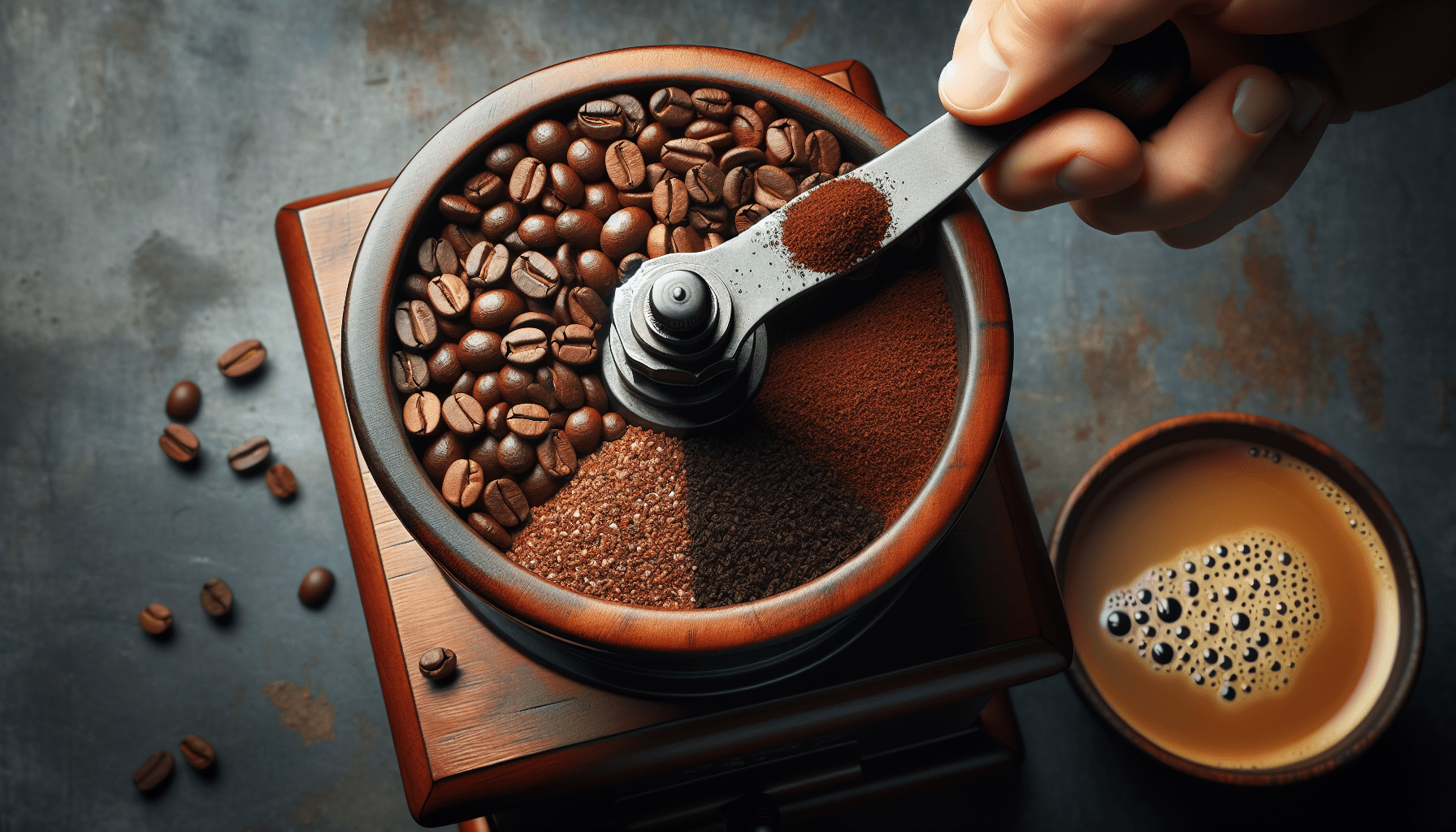Do you ever find yourself craving a refreshing caffeine boost on a hot summer day but can’t decide between cold brew and iced coffee? Well, fret no more! This article is here to shed some light on the key differences between these two popular chilled coffee options. By the time you’ve finished reading, you’ll be armed with the knowledge to confidently order your perfect icy beverage. So, grab a seat, and let’s find out what sets cold brew and iced coffee apart.
Preparation Method
Cold Brew
Cold brew is a brewing method that involves steeping coffee grounds in cold water over an extended period of time, typically 12 to 24 hours. The process of cold brewing allows the coffee to extract flavors slowly, resulting in a smoother and less acidic taste compared to traditional hot brewing methods. To make cold brew, coarse coffee grounds are mixed with cold water in a container and left to steep for the desired duration. The resulting concentrate is then typically diluted with water or milk before being served.
Iced Coffee
Iced coffee, on the other hand, is made by brewing coffee with hot water, usually using methods such as pour-over, French press, or espresso. Once brewed, the coffee is then cooled down by either refrigerating it or pouring it over ice. This method produces a quick and refreshing cup of iced coffee, which can be consumed immediately. Unlike cold brew, iced coffee tends to retain more of the acidity and brightness of the coffee beans, giving it a slightly sharper flavor profile.
Brewing Time
Cold Brew
As mentioned earlier, cold brew requires a longer brewing time compared to iced coffee. The extended steeping time allows the coffee grounds to slowly release their flavors and oils into the water, resulting in a strong and concentrated brew. Most cold brew recipes recommend steeping the coffee for around 12 to 24 hours, although some variations may require even longer brewing times for a more intense flavor.
Iced Coffee
Iced coffee brewing time is much shorter in comparison to cold brew. When brewing hot coffee, the process typically takes only a few minutes, depending on the brewing method used. Once the hot coffee is brewed, it is then rapidly cooled down by pouring it over ice or refrigerating it. This quick cooling process helps to lock in the flavors of the coffee while reducing the acidity, resulting in a refreshing and ready-to-drink iced coffee.
Brewing Temperature
Cold Brew
Cold brew, as the name suggests, is brewed with cold or room temperature water. The absence of heat during the brewing process contributes to the smooth and mellow taste of the final product. The low temperature also minimizes the extraction of certain compounds that can add bitterness to the coffee, resulting in a less acidic drink. Cold brew is often preferred by those who enjoy a less acidic and more mellow coffee experience.
Iced Coffee
On the other hand, iced coffee is brewed using hot water, typically at the same temperature as regular hot coffee. The hot water helps to extract the flavors and oils from the coffee grounds, resulting in a more robust and vibrant taste. Once the hot coffee is brewed, it is quickly cooled down to room temperature or below by either pouring it over ice or refrigerating it. This rapid cooling process helps to preserve the flavor compounds and aroma of the coffee while ensuring it is ready to be served over ice.
Coffee-to-Water Ratio
Cold Brew
When making cold brew, a higher coffee-to-water ratio is often used to compensate for the longer brewing time and achieve a concentrated brew. The recommended ratio for cold brew typically falls around 1 part coffee to 4 parts water. This ratio can be adjusted according to personal preference, with some preferring a stronger concentrate by increasing the coffee-to-water ratio. It’s important to note that cold brew concentrate is commonly diluted with water or milk before consumption to achieve the desired strength.
Iced Coffee
For iced coffee, the coffee-to-water ratio is typically the same as that used for regular hot coffee. This ratio can vary depending on the brewing method and desired strength, but a common guideline is 1 tablespoon of coffee grounds per 6 ounces (177 milliliters) of water. Adjustments can be made based on personal preference, such as using more coffee grounds for a bolder flavor or less for a milder taste. With iced coffee, the ratio is directly related to the strength of the final beverage.
Grind Size
Cold Brew
In cold brewing, a coarse grind size is commonly used. The larger coffee grounds allow for a slower extraction process and prevent over-extraction, resulting in a smoother and less bitter brew. The coarse grind size also helps to filter out any sediments or fines, ensuring a clean and clear cup of cold brew.
Iced Coffee
The grind size for iced coffee can vary depending on the brewing method used. For pour-over or drip brewing, a medium grind size is often recommended to ensure proper extraction without clogging the filter. For French press or espresso brewing, a coarser grind size may be preferable to avoid over-extraction. It’s important to adjust the grind size according to the specific equipment and brewing method to achieve the desired flavor profile for iced coffee.
Flavor Profile
Cold Brew
One of the key differences between cold brew and iced coffee lies in their flavor profiles. Cold brew has a reputation for delivering a smooth, low-acidity, and less bitter taste. The extended brewing time allows for a slower and more gentle extraction, resulting in a beverage with subtle flavor notes and a pronounced sweetness. Cold brew is often described as having a velvety texture and rich, chocolatey undertones, making it a popular choice for those who prefer a more mellow and less acidic coffee experience.
Iced Coffee
Iced coffee, on the other hand, tends to retain more of the acidity and brightness of the coffee beans. The hot brewing process extracts a wider range of flavors and oils, resulting in a cup of iced coffee with a more vibrant and complex taste. Iced coffee can exhibit fruity, floral, or nutty notes, depending on the origin and roast level of the coffee beans used. The sharper flavor profile of iced coffee makes it a refreshing choice, particularly for those who enjoy a brighter and more acidic cup of coffee.
Strength and Caffeine Content
Cold Brew
Cold brew is renowned for its strength due to the higher coffee-to-water ratio and longer brewing time. The resulting concentrate is typically stronger than regular hot coffee, requiring dilution with water or milk before being consumed. Despite its strong flavor, cold brew has a lower caffeine content compared to hot brewed coffee. The extended steeping time contributes to a slower extraction of caffeine, resulting in a milder caffeine kick. This makes cold brew a popular choice for coffee lovers who enjoy the taste of coffee without the jitters associated with high caffeine content.
Iced Coffee
Iced coffee, on the other hand, can have varying strengths depending on the brewing method and coffee-to-water ratio used. Iced coffee made with a standard coffee-to-water ratio and brewing time will have a similar caffeine content to regular hot coffee. However, some enthusiasts prefer a stronger iced coffee by increasing the coffee-to-water ratio or using a darker roast. It’s important to note that the overall caffeine content of iced coffee can also vary depending on personal taste preferences and brewing techniques.
Serving Temperature
Cold Brew
Cold brew is typically served cold or over ice, allowing for a refreshing and thirst-quenching coffee experience. The cold temperature enhances the smoothness and subtle flavors, making it an ideal choice for hot summer days or as a refreshing alternative to hot coffee. Cold brew can be consumed as is, or additional water, milk, or sweeteners can be added to customize the taste according to personal preference. Some coffee connoisseurs even enjoy experimenting with various flavorings such as vanilla or cinnamon to enhance the cold brew experience.
Iced Coffee
As the name suggests, iced coffee is served cold but not necessarily over ice. The coffee is cooled down using various methods such as pouring it over ice, refrigerating it, or a combination of both. The serving temperature can vary depending on personal preference, ranging from slightly chilled to ice-cold. Iced coffee can be enjoyed as a standalone drink or customized with cream, sweeteners, or flavor syrups to suit individual taste preferences. The versatility of serving temperature allows for a wide range of options when it comes to enjoying iced coffee.
Dilution Method
Cold Brew
Cold brew is typically diluted with water or milk before consumption. The strength of cold brew concentrate can be too intense for some, so dilution helps to achieve a more balanced and milder flavor profile. The ratio of concentrate to diluting liquid can vary depending on personal preference, ranging from a one-to-one ratio to a higher concentration of concentrate. Dilution allows for customization of the strength and flavor of cold brew, making it a versatile option for coffee lovers with diverse taste preferences.
Iced Coffee
Iced coffee can be enjoyed without dilution, particularly if brewed with a standard coffee-to-water ratio. However, some may also choose to dilute their iced coffee with water, milk, or even ice cream for a creamier and milder taste. Dilution methods for iced coffee can vary based on personal preference, with the goal of achieving a balanced and enjoyable beverage. Adding water or milk can help to tone down the strength and acidity, allowing for a smoother and more refreshing iced coffee experience.
Use of Ice
Cold Brew
When it comes to cold brew, ice is not an essential component in the brewing process. Cold brew is typically made by steeping coffee grounds in cold water, and the resulting concentrate can be served as is or with the addition of ice cubes. However, the use of ice is more common when serving cold brew, as it helps to chill the beverage and enhance the overall experience of drinking a cold and refreshing coffee.
Iced Coffee
On the other hand, ice is a fundamental component of iced coffee. The hot brewed coffee is cooled down rapidly by pouring it directly over a cup filled with ice cubes, causing the hot liquid to quickly reach a cold temperature. The ice cubes not only cool down the coffee but also dilute it, resulting in a ready-to-drink iced coffee with the desired strength and serving temperature. The incorporation of ice in iced coffee makes it an ideal choice for those looking for a quick and refreshing coffee fix.
In conclusion, while both cold brew and iced coffee are delicious ways to enjoy coffee, they have distinct characteristics that set them apart. Cold brew offers a smooth and mellow flavor profile with lower acidity and a longer brewing time, while iced coffee retains more of the coffee’s natural acidity and has a shorter brewing time. The choice between the two ultimately depends on personal preference and taste. Whether you prefer the subtle and velvety taste of cold brew or the bright and refreshing flavor of iced coffee, both options provide a delightful way to enjoy coffee, especially during warmer months. So go ahead, grab your cold brew or iced coffee, sit back, and savor the unique flavors and characteristics of each method. Cheers!




